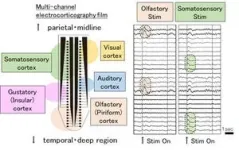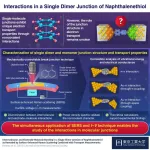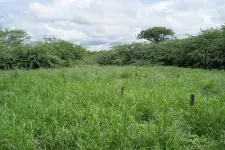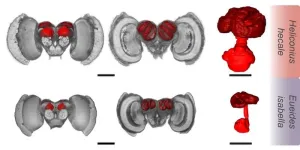(Press-News.org) Mycelium, an incredible network of fungal strands that can thrive on organic waste and in darkness, could be a basis for sustainable fireproofing. RMIT researchers are chemically manipulating its composition to harness its fire-retardant properties.
Associate Professor Tien Huynh, an expert in biotechnology and mycology, said they’ve shown that mycelium can be grown from renewable organic waste.
“Fungi are usually found in a composite form mixed with residual feed material, but we found a way to grow pure mycelium sheets that can be layered and engineered into different uses – from flat panels for the building industry to a leather-like material for the fashion industry,” said Huynh, from the School of Science.
The novel method of creating mycelium sheets that are paper-thin, like wallpaper, works without pulverising the mycelium’s filament network. Instead, they used different growth conditions and chemicals to make the thin, uniform and – importantly – first resistant, material.
Fungi fireproofing our buildings
The researchers are focused on creating bio-derived, fire-retardant cladding for buildings to prevent tragedies like the Grenfell Tower fire, in which the deadly blaze was accelerated by a highly combustible cladding component.
Associate Professor Everson Kandare, an expert in the flammability and thermal properties of biomaterials and co-author of the paper, said the mycelium has strong potential as a fireproofing material.
“The great thing about mycelium is that it forms a thermal protective char layer when exposed to fire or radiant heat. The longer and the higher temperature at which mycelium char survives, the better its use as a fireproof material,” said Kandare.
Beyond being effective, mycelium-based cladding can be produced from renewable organic waste and is not harmful to the environment when burned, he explained.
Where composite cladding panels are used, they usually contain plastics – which produce toxic fumes and heavy smoke when they burn.
“Bromide, iodide, phosphorus and nitrogen-containing fire retardants are effective, but have adverse health and environmental effects. They pose health and environmental concerns, as carcinogens and neurotoxins that can escape and persist in the environment cause harm to plant and animal life,” said Kandare.
“Bioderived mycelium produces naturally occurring water and carbon dioxide.”
Bringing the research to life
This research could eventually lead to improved and eco-friendly cladding for buildings.
“Plastics are quick and easy to produce, whereas fungi is slow to grow and relatively harder to produce at scale,” said Huynh.
“However, we’ve been approached by the mushroom industry about using their fungal-incorporated waste products. Collaborating with the mushroom industry would remove the need for new farms while producing products that meet fire safety needs in a sustainable way.”
The researchers are now looking to create fungal mats reinforced by engineering fibres to delay ignition, reduce the flaming intensity and improve fire safety ranking.
The paper, “Fireproofing flammable composites using mycelium: Investigating the effect of deacetylation on the thermal stability and fire reaction properties of mycelium” (https://doi.org/10.1016/j.polymdegradstab.2023.110419, lead author Nattanan Chulikavit), is published in the journal Polymer Degradation and Stability.
It builds on preliminary research published by the experts in high-ranked international journals, Polymer Degradation and Stability and Nature’s Scientific Reports.
This project is a major collaboration involving RMIT University, the University of New South Wales, the Hong Kong Polytechnic University and the Australian Research Council Training Centre in Fire Retardant Materials and Safety Technologies.
END
Fungi blaze a trail to fireproof cladding
RMIT scientists have shown it’s possible to grow fungi in thin sheets that could be used for fire-retardant cladding or even a new kind of fungal fashion.
2023-07-13
ELSE PRESS RELEASES FROM THIS DATE:
Investigating interactions at molecular junctions for novel electronic devices
2023-07-13
The structure of a molecular junction with noncovalent interaction plays a key role in electron transport, reveals a recent study conducted by researchers at Tokyo Tech. Through simultaneous surface-enhanced Raman scattering and current–voltage measurements, they found that a single dimer junction of naphthalenethiol molecule shows three different bondings, namely π–π intermolecular and through-π and through-space molecule–electrode interactions.
The π–π interaction is a type of noncovalent interaction that occurs when the electron clouds in the π orbitals ...
Researchers report advance in immune therapy against ALS
2023-07-13
New research suggests that targeting autoimmune inflammation associated with amyotrophic lateral sclerosis (ALS) using two drugs, one of them already approved for multiple sclerosis, could be a promising approach for treatment.
ALS, also known as Lou Gehrig's disease, is a progressive neurodegenerative disease that affects the nerve cells in the brain and spinal cord. It leads to the gradual loss of muscle control, eventually resulting in paralysis and difficulty with speech, swallowing, and breathing. The exact cause of ALS is not fully understood, and currently, there is no cure ...
Taylor & Francis reduces plastic by introducing paperwrap for UK mailed journals
2023-07-13
Taylor & Francis has taken a significant step in reducing unnecessary plastic use with the introduction of paperwrap for journal print copies mailed in the UK.
Paperwrap, a relatively new packaging technology, has become more common in recent years, but is typically most suited to publications with very high print runs. Taylor & Francis’ Global Supplier Team spent several months investigating how it might be applied to journal print runs, which included rolling out live trial mailings to colleagues around the world to test how the journals could be packaged, and whether there was any impact on the speed ...
New talking therapy for depression could be more effective and cheaper than CBT
2023-07-13
A new talking therapy for depression has shown encouraging early signs of being more effective and cheaper to deliver than the current best practice of Cognitive Behavioural Therapy (CBT).
A pilot trial from the University of Exeter, funded by the National Institute of Health and Care Research (NIHR) and published in Lancet EClinical Medicine, has found Augmented Depression Therapy (ADepT) could be a significant advance in depression care.
A core feature of depression is anhedonia (reduced ...
Three ways to fight invasive Prosopis juliflora tree in Eastern Africa all proved very effective, new study shows
2023-07-13
A team of scientists led by CABI have conducted a new study which shows that three ways to fight the invasive Prosopis juliflora tree in Ethiopia, Kenya and Tanzania all proved very effective in almost all cases.
The three-year research, published in the journal CABI Agriculture and Bioscience, revealed that cut stump and basal bark herbicide application and manual uprooting were highly effective, killing the trees in between 85-100% of cases.
In addition, three incremental restoration interventions were tested ...
Poignant photo project reveals all we lost in lockdown
2023-07-13
Laptops and schoolwork on kitchen tables, a deserted playground, face masks on a washing line, an empty church, a walk in the woods.
As the UK Covid inquiry continues for a fifth week, researchers at the University of East Anglia have created a unique snapshot of lockdown life.
When the pandemic first hit, the team embarked on a project to track the physical and mental health of the nation. More than a thousand participants signed up and up and they were followed every day for three months in the first study of its kind.
As well as keeping daily lifestyle diaries about their physical activity, diet and mood, ...
Butterfly species’ big brains adapted giving them a survival edge, study finds
2023-07-13
Heliconius butterflies’ brains grew as they adopted a novel foraging behaviour, scientists at the University of Bristol have found.
A region of their brain, known as the mushroom body due to its shape, are two to four times larger than those of their close relatives.
The findings, published today in Nature Communications, suggest that the structure and function of the nervous system are closely linked to an organism's ecological niche and behaviour.
Dr Stephen Montgomery of Bristol’s School of Biological Sciences explained: “Heliconius are the only butterflies known to collect and digest pollen, which gives them an adult source ...
Combination cancer therapies can shrink tumors and improve survival outcomes for patients with advanced non-small lung cancer
2023-07-13
New Haven, Conn. — While pembrolizumab is an approved treatment for patients with stage III non-small cell lung cancer (NSCLC), only some patients respond to this therapy. Treatment failure, researchers say, is often caused by differences in the tumor microenvironment. An ongoing phase II study (KEYNOTE-495/KeyImPaCT) led by a researcher at Yale Cancer Center reveals that combining pembrolizumab with other treatments reduced the size of target tumors, resulting in a higher response rate for patients with advanced NSCLC.
The new research was published July 10 in Nature Medicine.
“We are excited to share these new ...
NSF CAREER award invests in the future of stable computing
2023-07-12
Every night, uncounted numbers of devices across the globe update their operating systems (OS), and everyday users log on expecting fast, secure connections and services to keep their increasingly online lives moving forward. But as artificial intelligence and other more complex systems come online, the foundation of all them is teetering.
Every aspect of society — from government and industry to education and entertainment — relies on devices with stable operating systems. And every OS relies on ...
Collaborative seed grants nurture high-impact social and environmental research
2023-07-12
The National Science Foundation, the National Institutes of Health, and the National Aeronautics and Space Administration have collectively awarded millions of dollars in grant funding to numerous Virginia Tech researchers who all have one thing in common.
They were awarded Emerging Social Aspects of Global Change seed funding.
Since 2015, this funding has led to faculty from seven colleges and 15 departments collaborating and engaging in 10 research projects that address the social or policy aspects of major global environmental issues.
Sponsored by Fralin Life Sciences Institute’s Global Change Center and the Institute ...
LAST 30 PRESS RELEASES:
Fathers’ microplastic exposure tied to their children’s metabolic problems
Research validates laboratory model for studying high-grade serous ovarian cancer
SIR 2026 delivers transformative breakthroughs in minimally invasive medicine to improve patient care
Stem Cell Reports most downloaded papers of 2025 highlight the breadth and impact of stem cell research
Oxford-led study estimates NHS spends around 3% of its primary and secondary care budget on the health impacts of heat and cold in England
A researcher’s long quest leads to a smart composite breakthrough
Urban wild bees act as “microbial sensors” of city health.
New study finds where you live affects recovery after a hip fracture
Forecasting the impact of fully automated vehicle adoption on US road traffic injuries
Alcohol-related hospitalizations from 2016 to 2022
Semaglutide and hospitalizations in patients with obesity and established cardiovascular disease
Researchers ‘listen in’ to embryo-mother interactions during implantation using a culture system replicating the womb lining
How changing your diet could help save the world
How to make AI truly scalable and reliable for real-time traffic assignment?
Beyond fragmented markets: A new framework for efficient and stable ride-pooling
Can shape priors make road perception more reliable for autonomous driving?
AI tracks nearly 100 years of aging research, revealing key trends and gaps
Innovative techniques enable Italy’s first imaging of individual trapped atoms
KIER successfully develops Korea-made “calibration thermoelectric module” for measuring thermoelectric device performance
Diversifying US Midwest farming for stability and resilience
Emphasizing immigrants’ deservingness shifts attitudes
Japanese eels, climate change, and river temperature
Pusan National University researchers discover faster, smarter heat treatment for lightweight magnesium metals
China’s 2024 Gastroenterology Report: marked progress in endoscopy quality and disease management
Pusan National University researchers uncover scalable method for ultrahigh-resolution quantum dot displays
Researchers use robotics to find potential new antibiotic among hundreds of metal complexes
Gut bacteria changes at the earliest stages of inflammatory bowel disease
Scientists develop new way to “listen in” on the brain’s hidden language
Brain research: “Pulse generators” grow and shrink as memories are formed
For teens, any cannabis use may have impact on emotional health, academic performance
[Press-News.org] Fungi blaze a trail to fireproof claddingRMIT scientists have shown it’s possible to grow fungi in thin sheets that could be used for fire-retardant cladding or even a new kind of fungal fashion.








